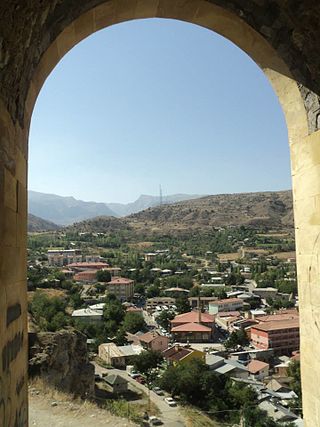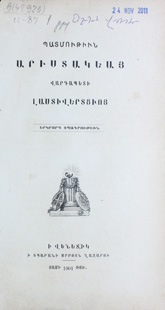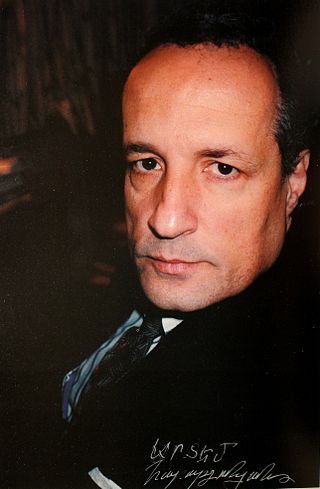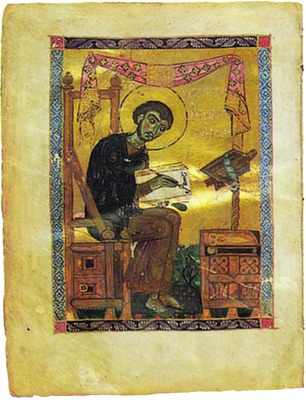The history of literature is the historical development of writings in prose or poetry that attempt to provide entertainment or education to the reader, as well as the development of the literary techniques used in the communication of these pieces. Not all writings constitute literature. Some recorded materials, such as compilations of data are not considered literature, and this article relates only to the evolution of the works defined above.

Grigor Narekatsi was an Armenian mystical and lyrical poet, monk, and theologian. He is venerated as a saint in the Armenian Apostolic and Catholic Churches and was declared a Doctor of the Church by Pope Francis in 2015.

Alexander Minasi Movsisian, better known by his pen name Alexander Shirvanzadeh was an Armenian playwright and novelist. He was one of the main representatives of the realist movement in Armenian literature.

Kirakos Gandzaketsi was an Armenian historian of the 13th century and author of the History of Armenia, a summary of events from the 4th to the 12th century and a detailed description of the events of his own days. The work concentrates primarily on the history of Medieval Armenia and events occurring in the Caucasus and Near East. The work serves as a primary source for the study of the Mongol invasions and even contains the first recorded word list of the Mongolian language. The work has been translated into several languages including Latin, French and Russian.

Khosrovidukht was an Armenian hymnographer and poet who lived during the early 8th century. After her slightly earlier contemporary Sahakdukht, she is the first known woman of Armenian literature and music, and among the earliest woman composers in the history of music.

Sahakdukht was an Armenian hymnographer, poet and pedagogue who lived during the early 8th century. She is the first known woman of Armenian literature and music. Along with her slightly later contemporary Khosrovidukht, she is among the earliest woman composers in history.
The history of Gujarati literature may be traced to 1000 AD, and this literature has flourished since then to the present. It is unique in having almost no patronage from a ruling dynasty, other than its composers.

Ghevont Alishan was an Armenian Catholic priest, historian, educator and poet. He was a prolific author throughout his long career and gained recognition from Armenians and European academic circles for his contributions to Armenian literature and scholarship.

Eznik of Kolb was an Armenian Christian writer of the 5th century. He was one of the students of Mesrop Mashtots, the inventor of the Armenian alphabet. His only surviving work is an untitled treatise which refutes various religious and philosophical ideas. Scholars refer to this work as Refutation of the Sects or On God. Travelling to Edessa and Constantinople, Eznik participated in the translation of the Bible and other Christian literature from Greek and Syriac into Armenian. He is believed to be identical with a bishop of Bagrevand named Eznik.

Manuk Khachaturi Abeghyan was an Armenian philologist, literary scholar, folklorist, lexicographer and linguist. He authored numerous scholarly works, including a comprehensive two-volume history of old Armenian literature titled Hayots’ hin grakanut’yan patmut’yun (1944–1946), and a volume on Armenian folklore, the German version of which is titled Der armenische Volksglaube. He worked extensively on the compilation and study of the Armenian national epic Daredevils of Sassoun. He is also remembered as the main designer of the reformed Armenian orthography used in Armenia to this day. He was one of the first professors of Yerevan State University and was a founding member of the Armenian National Academy of Sciences. The Institute of Literature of the National Academy of Sciences of Armenia is named in his honor.

Aristakes Lastivertsi was a medieval Armenian historian and chronicler. The author of many works, Aristakes's most valuable contribution in the field of the historiography was his History About the Sufferings Occasioned by Foreign Peoples Living Around Us, which describes Bagratid Armenia's relations with the Byzantine Empire and Georgia and the devastating Seljuk invasions of the 11th century and the torture of Christians by the Seljuks.

Bedros Tourian was an Armenian poet, playwright and actor. His career was cut short when he died of tuberculosis at the age of twenty, but he gained lasting renown for his highly personal and innovative lyric poetry.

Raphael Patkanian, also known by the penname Gamar Katipa, was a nineteenth-century Russian Armenian writer and educator. He was born into a noted family of Armenian intellectuals in Nakhichevan-on-Don and began writing in his student years. He gained popularity for his poetry, much of which is written on patriotic themes.

Derenik Karapeti Demirchian was a Soviet and Armenian writer, novelist, poet, translator and playwright. He began his career as a poet, but later transitioned into prose writing. He was a prolific writer whose works deal with a wide variety of subjects. He is perhaps best known for his historical novel Vardanank (1943), which is a dramatization of the 5th-century Armenian rebellion led by Vardan Mamikonian.
Paghtasar Dpir, or Baghdasar Tbir, was an Armenian poet, musician, scientist, printer, and a luminary of national and educational movements. He is considered a leading figure during the revitalization period of Armenian culture.

Hovhannes Imastaser, also known as Hovhannes Sarkavag, was a medieval Armenian multi-disciplinary scholar known for his works on philosophy, theology, mathematics, cosmology, and literature. He was also a gifted hymnologist and pedagogue.

Poetry of Scotland includes all forms of verse written in Brythonic, Latin, Scottish Gaelic, Scots, French, English and Esperanto and any language in which poetry has been written within the boundaries of modern Scotland, or by Scottish people.

Artem Harutyunyan is an Armenian writer, translator, critic, Doctor of Philology, Professor, member of Writers Union of Armenia,

Hovhannes Hovhannisyan was an Armenian poet, translator and educator. While he was not very prolific, his melancholic poetry has been praised for its lyrical quality and form and was influential for subsequent Armenian poets.

Alongside old Armenian historiography and translated literature, poetry constituted a significant part of Armenian literature from the 5th to the 18th centuries. The rich tradition of oral literature preceded written poetry.

















